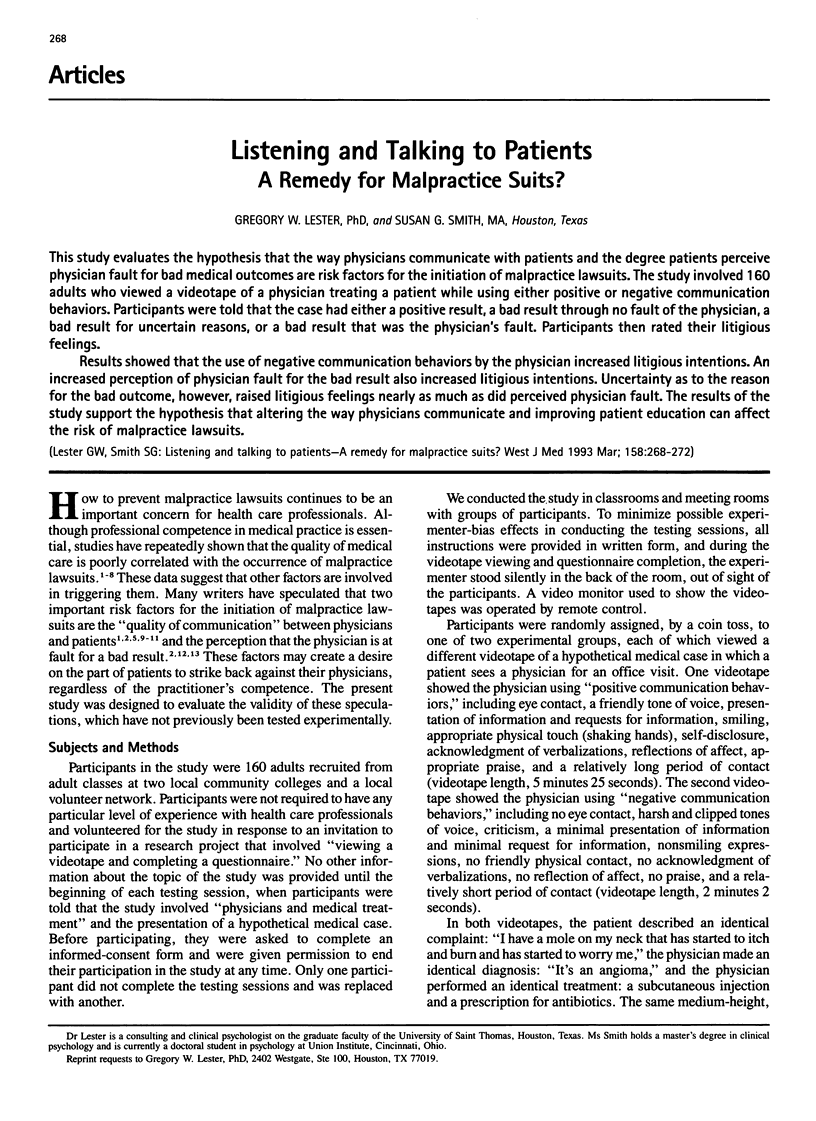Abstract
This study evaluates the hypothesis that the way physicians communicate with patients and the degree patients perceive physician fault for bad medical outcomes are risk factors for the initiation of malpractice lawsuits. The study involved 160 adults who viewed a videotape of a physician treating a patient while using either positive or negative communication behaviors. Participants were told that the case had either a positive result, a bad result through no fault of the physician, a bad result for uncertain reasons, or a bad result that was the physician's fault. Participants then rated their litigious feelings. Results showed that the use of negative communication behaviors by the physician increased litigious intentions. An increased perception of physician fault for the bad result also increased litigious intentions. Uncertainty as to the reason for the bad outcome, however, raised litigious feelings nearly as much as did perceived physician fault. The results of the study support the hypothesis that altering the way physicians communicate and improving patient education can affect the risk of malpractice lawsuits.
Full text
PDF




Selected References
These references are in PubMed. This may not be the complete list of references from this article.
- Brennan T. A., Leape L. L., Laird N. M., Hebert L., Localio A. R., Lawthers A. G., Newhouse J. P., Weiler P. C., Hiatt H. H. Incidence of adverse events and negligence in hospitalized patients. Results of the Harvard Medical Practice Study I. N Engl J Med. 1991 Feb 7;324(6):370–376. doi: 10.1056/NEJM199102073240604. [DOI] [PubMed] [Google Scholar]
- Gregory D. R. Medical malpractice prevention. Leg Med. 1982:177–186. [PubMed] [Google Scholar]
- Gutheil T. G., Bursztajn H., Brodsky A. Malpractice prevention through the sharing of uncertainty. Informed consent and the therapeutic alliance. N Engl J Med. 1984 Jul 5;311(1):49–51. doi: 10.1056/NEJM198407053110110. [DOI] [PubMed] [Google Scholar]
- Herbert V. A proposed solution to the malpractice problem. N Y State J Med. 1986 Jul;86(7):394–395. [PubMed] [Google Scholar]
- Localio A. R., Lawthers A. G., Brennan T. A., Laird N. M., Hebert L. E., Peterson L. M., Newhouse J. P., Weiler P. C., Hiatt H. H. Relation between malpractice claims and adverse events due to negligence. Results of the Harvard Medical Practice Study III. N Engl J Med. 1991 Jul 25;325(4):245–251. doi: 10.1056/NEJM199107253250405. [DOI] [PubMed] [Google Scholar]
- O'Keeffe D. F. Efforts of the Medical Society of the State of New York to effect medical liability reform. N Y State J Med. 1986 Jul;86(7):339–341. [PubMed] [Google Scholar]
- Sowka M. P. The medical malpractice closed claims study. Conducted by the National Association of Insurance Commissioners. Conn Med. 1981 Feb;45(2):91–101. [PubMed] [Google Scholar]


